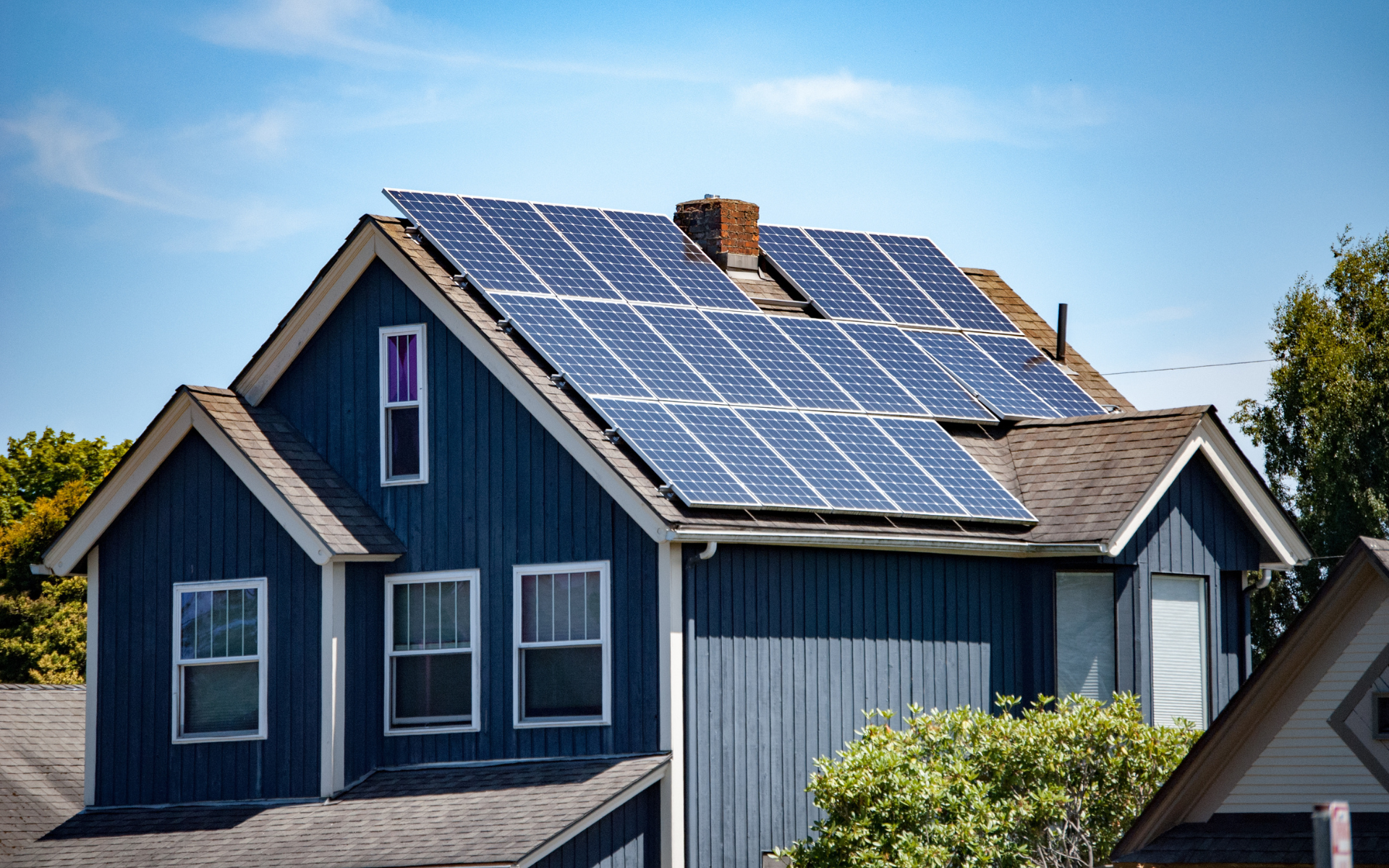Home Solar 101: Your Guide to All Things Solar

6 Min. Read
Written by Casey McDevitt and edited by Emily Walker with EnergySage
Solar power is one of the fastest-growing sources of clean energy thanks to declining costs, generous incentive programs, and rapidly improving technology.
Home solar panel systems are more efficient, affordable, and reliable than ever. While it’s never been easier to go solar, it’s important to understand the basics before you invest in a system.
In this article, we break down the most important things you need to know when exploring your home solar options. Spoiler alert: the best way to go solar with confidence is to compare quotes.
Why Would You Want to Go Solar?
Most people go solar to save on electricity bills, but home solar panel systems offer valuable financial and environmental benefits:
Financial Benefits of Solar
One of the biggest benefits of home solar systems is the significant reduction (or elimination) of electricity bills.
Utility energy rates are expensive and turbulent; depending on where you live, powering your home with 100% grid-produced electricity can cost you thousands of dollars every year. On the other hand, homes with solar panels run on emission-free electricity produced directly on their property.
The average homeowner can save between $20,000 and $97,000 over the life of their solar panel system. Home solar systems further boost financial savings for electric vehicle (EV) owners.
While EV owners can avoid gasoline prices, without solar they are still paying relatively high retail utility rates for electricity. But, if they charge their EVs with electricity produced by their solar panels, it’s even less expensive.
Environmental Benefits of Solar
Not only is utility-produced electricity expensive, but it often comes from carbon-emitting fossil-fuel-based power plants. By installing solar panels on your home, you reduce your carbon footprint and lessen our collective reliance on fossil fuels.
In general, your home solar panel system will eliminate 3-4 tons of carbon emissions each year: the equivalent of planting 100 trees.
Learn more about the benefits of solar.
How Much Does Solar Cost?
In 2023, a solar panel system in the U.S. costs an average of $20,020. Ultimately, your system’s cost will depend on several factors, such as the system size, your location, the characteristics of your roof, and the quality of your system’s equipment.
The best way to understand how much it will cost you to go solar is to connect with a trusted solar professional, like an unbiased energy advisor or a reputable installer in your area.
Learn more about the cost of solar.
Best Solar Incentives
Financial incentives, like rebates and tax credits, exist to encourage the adoption of solar energy and help meet local, state, and federal net-zero emissions goals.
Importantly, some solar incentives have a finite lifetime and gradually drop in value until they are eventually phased out completely (although, it’s not uncommon to extend the timelines and benefits of these incentives). Luckily, many solar incentives available today are at their highest.
Here are some of the best solar incentives to know about:
Federal Investment Tax Credit
The Investment Tax Credit (ITC) allows you to apply 30% of your solar system’s cost as a credit to your federal tax bill.
Unlike a tax deduction that lowers your adjusted gross income, the ITC reduces your tax liability dollar-for-dollar. This will lower your tax bill if you owe taxes, or could even result in a larger tax refund from the IRS.
Due to its ability to significantly reduce the cost of going solar, the ITC is considered one of the most beneficial solar incentives.
State SRECs
State incentives vary widely, but many have established markets for solar renewable energy certificates (SRECs).
Put simply, some states require utilities to generate a certain amount of their electricity from renewable sources. To meet these requirements, utility companies can purchase SRECs from solar owners like you; this is representative of the impact your solar panels have in effectively replacing the energy you would have pulled from a utility power plant.
Net Metering
Net metering allows you to use the grid to essentially store excess energy produced by your solar panels.
Under net metering, when your system generates more electricity than you use, you can send it to the grid in exchange for credits. Your utility company will then apply these credits to your electric bill, offsetting the electricity you consume from the grid when your solar panels aren’t generating enough to meet your energy needs.
So, as a solar customer, your utility bill will only reflect your “net” electricity usage. Net metering programs can differ from state to state, much like SREC programs.
Learn more about federal and state solar incentives.
Are You a Good Fit for Solar?
Every home has unique energy needs, and while solar is a great solution for many houses, it doesn’t make sense for everyone. There are a few key factors that determine if you’re a good fit for solar or not:
How Much You Currently Spend on Electricity
You can experience solar savings no matter how much you currently spend on electricity, but the higher your utility bills are, the more you can save by going solar.
People living in states with expensive electricity rates and those who consume a significant amount of energy are typically ideal candidates for solar panels.
The Characteristics of Your Roof
Unfortunately, not all roofs are suitable for solar panels. Your roof’s age, material, size, shading, tilt, and orientation all contribute to the viability of your home as a candidate for solar panels.
For optimal solar production, a roof should be south-facing, experience minimal shading throughout the day, have a tilt between 30 to 45 degrees, have plenty of open space, and be in good enough condition to support the solar panels for 25 to 30 years.
Where You Live
Things like labor, equipment availability, and permitting cause the cost of solar to vary throughout the country. For example, a 6-kilowatt solar system may cost $14,760 in Arizona and $22,320 in Indiana. But, as we mentioned, incentives can drive down the cost of solar significantly.
Learn more about what a good fit for solar looks like.
How to Go Solar Without Installing Panels
You can still experience the benefits of solar even if your home is not well suited for rooftop solar.
Whether you rent or your roof just isn’t a good fit for solar panels, community solar allows you to save on your electricity bill without installing a single solar panel on your property.
Here’s how it works: a local community solar farm generates and sends electricity to the grid. Residents, businesses, and organizations serviced by the cooperating utility can opt to subscribe to a “share” of the solar farm and receive credits on their electricity bills based on how much their share generates.
With little to no upfront costs required, you can expect to save 5-15% annually on your electric bills simply by subscribing to a local community solar farm.
Explore, compare, and subscribe to community solar projects through the EnergySage Community Solar Marketplace.
Paying for Solar
There are a few ways to finance your solar panels: with cash upfront, a lease, or through a solar loan (some of which are $0-down).
Paying with cash upfront offers the greatest savings over time, but this option isn’t possible for everyone.
Leasing your solar panels won’t save you as much over the lifetime of the system and will even disqualify you from some solar incentives. But, with this option, you will typically still receive electricity at a discounted rate.
Lastly, taking out a solar loan allows you to pay off your system in monthly installments while maintaining ownership – this is a great option for many homeowners because you’re still eligible for incentives without having to pay a lot upfront.
How to Go Solar
Whether you decide to install solar panels on your roof or subscribe to a community solar farm, the next step is to compare quotes from local installers in your area to ensure that you pay a fair price.
It may seem tedious to gather and compare quotes, but if you shop through the EnergySage Marketplace, they’ll do all the heavy lifting for you. Plus, homeowners who go solar through EnergySage pay ~20% less than shopping alone!
The best part: EnergySage is a free service that partners with only vetted, reputable installers to provide custom quote comparisons so you can go solar with confidence.
